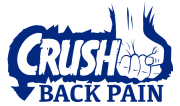Herniated disc exercises need to engage the core and gluteal musculature without placing excessive load through the disc
Instead of labeling exercises as “herniated disc exercises” it’s more beneficial to understand what type of lower back motion exacerbates a herniated disc and what type of movement benefits a herniated disc.
Repetitive lumbar flexion and end-range flexion often cause discs to herniate. When a disc is already herniated lumbar flexion can exacerbate the herniation or keep it from healing.
Lumbar flexion compresses the disc and places tensile load through the posterior disc, where herniations occur.
Lumbar extension reduces tensile loading through the posterior disc
Exercises that are beneficial to the disc are dependent on symptoms.
If leg pain/radicular pain (sciatica) is present you first want to see if the leg pain will centralize. With herniated discs extension is the direction of movement that most frequently results in centralization. If the leg symptoms do centralize the direction of movement that centralizes the pain is used as a treatment. McKenzie exercises are extension based exercises to centralize leg pain.
As leg pain decreases the exercises are transitioned to lumbar stabilization training.
If there is no leg pain, pain is localized to the lower back, lumbar stabilization exercises are the primary focus right off the bat
Lumbar stabilization exercises should maintain the lower back in a neutral position to minimize compression and tensile loading through the disc. When the lumbar spine is maintained in a neutral position the trunk, leg, and arm muscles can be worked without negatively affecting the disc.
Here is an article that covers herniated disc exercises in depth.
Instead of worrying about specific herniated disc exercises, understand how to make most exercises safe and beneficial for a herniated disc
This way an entire full body training program can be built that is disc friendly.


